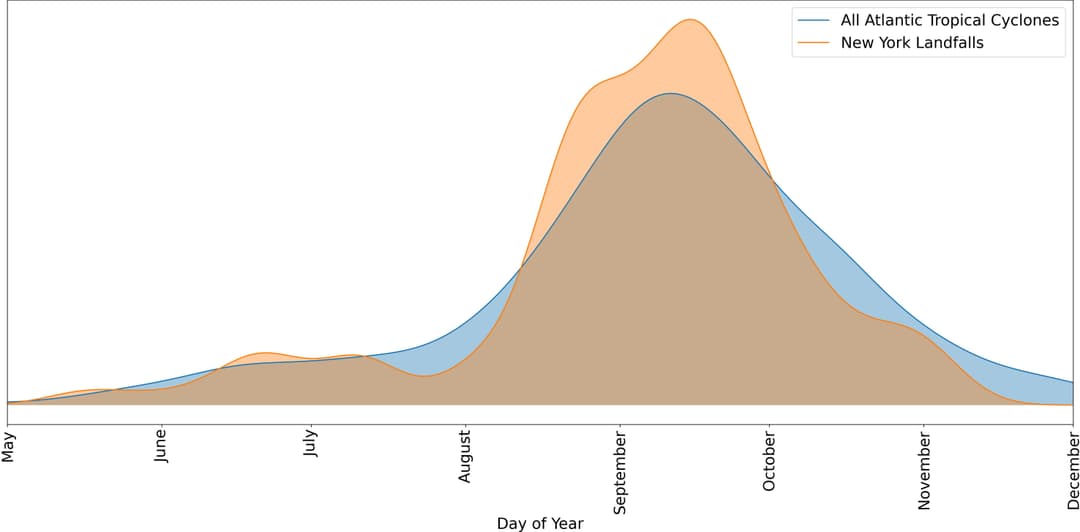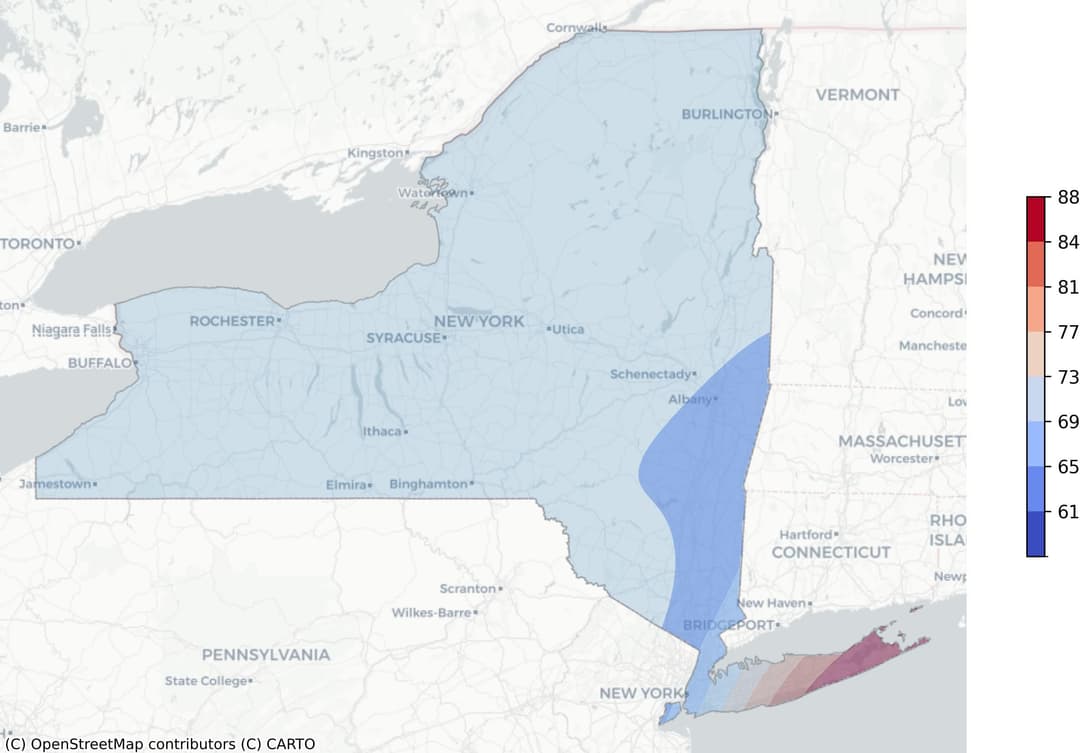Hurricanes in New York
When is Hurricane Season in New York?
The official hurricane season in New York aligns with the Atlantic hurricane season, which lasts from June 1 to November 30. During this period, New York is susceptible to the impacts of tropical** storms**, *tropical depressions*, or even *major hurricanes*.
Despite being on the northern periphery of the hurricane belt, New York's exposure to hurricanes is not insignificant compared to other states. Historically, significant hurricanes, such as the Long Island Express in 1938 and Hurricane Sandy in 2012, have made landfall in New York, causing widespread damage and loss of life.
Our study, based on hurricane paths dating back to 1851, offers insights into the historical frequency of tropical cyclones affecting New York.

The image shows the likelihood of experiencing a tropical cyclone on a particular day of the year. It juxtaposes the actual storm landfalls in New York with the storm pattern in the entire Atlantic basin. The raw data for this image is sourced from the NOAA Hurricane Research Division.
Where Do Hurricanes Hit Most in New York?
Areas most prone to hurricanes within New York are those along the coast, specifically Long Island, the New York City metropolitan area, and the Lower Hudson Valley.These regions are highly susceptible to hurricanes due to their geographical location and proximity to the Atlantic Ocean.
Long Island, surrounded by water on all sides, is particularly vulnerable to storm surge and flooding during hurricanes, as sea level rise worsens flooding, erosions, and storm surges. The New York City metropolitan area, with its dense population and infrastructure, is not only at risk of flooding but also potentially catastrophic damage from hurricane-force winds.
Although theLower Hudson Valley isslightly more inland, it is not immune to these threats, especially when hurricanes move northward along the coast.
To illustrate these risks, consider the following heatmap:

This map represents the frequency of hurricanes in New York, weighted by wind speed. Areas that are frequently hit by hurricanes with high wind speeds are shown in red, while areas with less frequent or less severe hurricanes are shown in blue. Hurricane Sandy
This catastrophic storm hit New York in October 2012, causing an estimated $50 billion in damage, making it the second-costliest cyclone in the United States. There were 72 direct fatalities recorded in the mid-Atlantic and northeastern United States, the highest number outside of the southern states since Hurricane Agnes in 1972. New York was one of the most affected states, with 48 deaths. The storm surge was responsible for most of the fatalities, with falling trees during the storm killing 20 people. The hurricane also caused significant damage to the local fishing industry, docks, marinas, and fish processing plants. Sandy left approximately 650,000 houses damaged or destroyed, with about 8.5 million customers losing power.
How to Prepare for a Hurricane Season in New York
Preparation for a storm, particularly a hurricane, is of paramount importance. The proactive steps taken before the storm can significantly mitigate the impact and potential damage. Before a Hurricane
When it comes to hurricane preparedness, it is crucial to take a proactive approach. Below is a brief hurricane preparation checklist that may assist in safeguarding both life and property.
- Keep a constant check on weather updates and news broadcasts for the latest information about the hurricane.
- Secure your home by closing and boarding up windows, and consider installing hurricane shutters.
- Compile a disaster supply kit. This should include items like bottled water, non-perishable food, first-aid supplies, personal hygiene items, portable chargers, flashlights, and batteries.
- Make sure you have a plan for your pets. Not all shelters will accommodate them, so plan accordingly.
- Check your insurance policies to ensure they cover damages caused by hurricanes.
- Make a family communication plan. It's essential to know how you'll contact one another and where you'll meet if you can't go home.
- Prepare your car. Fill your gas tank, check the tires, and ensure your car is in good working condition.
- If you live in a mandatory evacuation zone, plan where you'll stay and how you'll get there. It could be a hotel, a relative's home, or a designated shelter.
During a Hurricane
In the face of a hurricane, it is vital to take certain precautions to ensure safety. Below is a concise list of actions to follow that align with the topic of what to do during a hurricane:
- Stay informed: Monitor local news and weather reports for updates and instructions.
- Seek shelter: If evacuation is not an option, stay indoors, away from windows and glass doors.
- Secure your surroundings: Close all interior doors, secure and brace external doors.
- Prepare for power outages: Keep flashlights and extra batteries handy. Avoid using candles due to the risk of fire.
- Avoid flood water: Do not walk, swim, or drive through flood water. It may be electrified or contaminated.
- Have an emergency kit: Ensure you have enough food, water, medications, and other essentials for at least three days.
- Communicate: Let loved ones know your plans and whereabouts. Keep your mobile devices charged.
After a Hurricane
Once a hurricane has passed, it is crucial to take certain steps to ensure safety and begin recovery. Here are some steps on what to do after a hurricane:
- Check for injuries and damages: Ensure the safety of yourself and others around you. Check for any damages to your property or surroundings.
- Contact your insurance company: File an insurance claim for any damages to your property. It's advisable to take photos of the damage as evidence.
- Contact FEMA: If your insurance does not cover the damage, or if you do not have insurance, you can apply for assistance from the Federal Emergency Management Agency (FEMA).
- Assess your vehicle: If your vehicle was damaged, you may need to file a car insurance claim. Similar to property damage, document the damage with photographs.